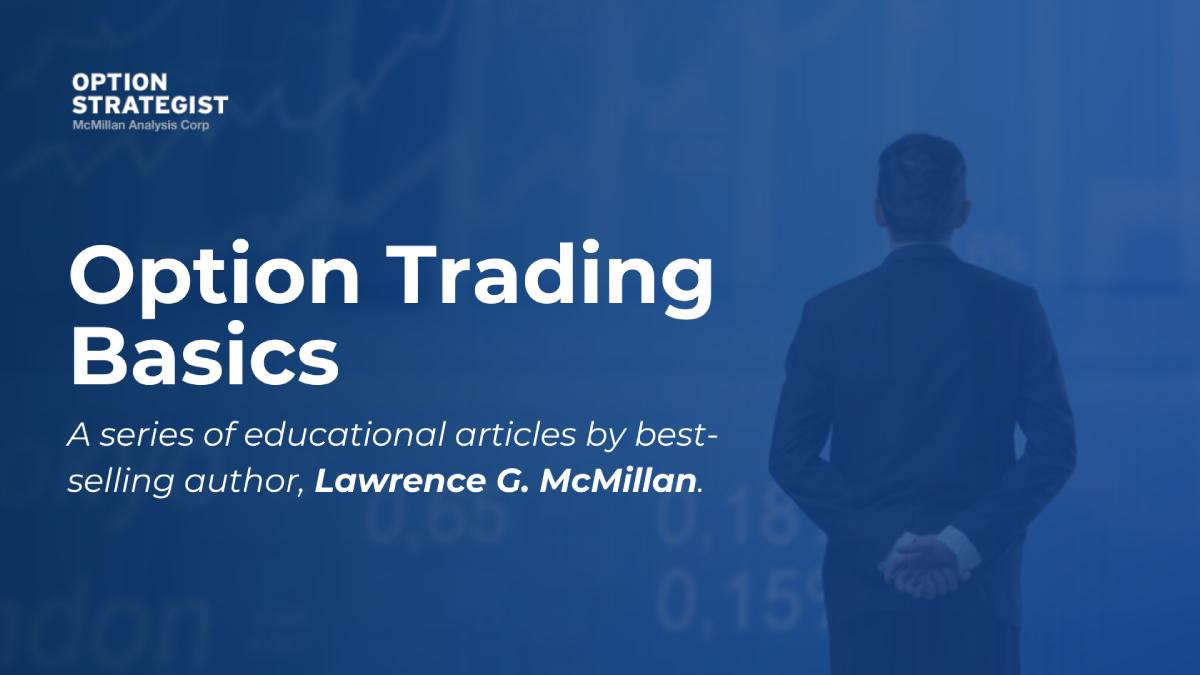
By Lawrence G. McMillan
This article was originally published in The Option Strategist Newsletter Volume 4, No. 1 on January 12, 1995.
Buying options is often regarded as one of the most speculative activities. However, as we have shown time and time again, there are often differing ways in which one can establish a strategy. These different ways may change the speculative to the conservative, or at least moderate things somewhat. Buying options is no exception.
Before actually discussing the type of option one should purchase, it must be stated that one's outlook for the performance of the stock is of utmost importance. If the underlying stock drops in price, you are not going to profit from a call option purchase, no matter which call you buy.
The main attraction for buying options — at least to the average or novice trader — is the leverage that is available. You can put up a fairly small amount of money (a couple of thousand dollars) and make returns in the 200% or 300% area. Of course you can lose 100% fairly quickly as well.
In this regard, many novice traders buy out-of-the-money options in order to keep their cost down. They then dream of huge potential returns, but these returns are usually attainable only if the stock can make a rather large percentage move. To make matters worse, the typical buyer of out-of-the-money options buys options that have too short of a life span — he does not give the stock enough time to make the large move that is required.
Over the years, I have spoken to numerous stock traders who have given up on options. They feel that they can make money trading stock, but always seem to lose when options are concerned. Their problems generally result from one mistake: buying too far out-of-the-money.
Professional stock traders use options for one purpose only: to reduce their required investment in a position. They are not attempting to capture huge leveraged returns; rather they are merely using the option as a substitute for the stock itself. In order to create an option position that is virtually the equivalent of a stock position, one should buy in-the-money options, probably with little time remaining. Moreover, if one normally trades 2000 shares of stock, then the professional would probably buy 20 in-the-money calls; he does not usually attempt to leverage himself.
By buying in-the-money options, one is minimizing the amount of money spent for time value premium. Time value premium is the part of an option that wastes away as time passes. Outof- the-money options are entirely composed of time value premium. In-the-money options may have little, or sometimes even no time value premium.
Secondly, the in-the-money option will most closely match the performance of the underlying stock on a day-to-day basis. If the stock is up a point, the in-the-money call option will probably rise in price by at least 3/4 of a point or more. The out-of-the-money option may not move much at all. Of course,this fact could work against the call option holder if the stock moves down in price. That is why we originally stated that stock selection is of utmost importance.
Example: An example may be helpful. Suppose that one has decided that XYZ is a good stock to buy for a short-term trade, and the stock is selling for 19 per share. If today were the first trading day of the year, which option would you buy?
| Call Option | Offering Price |
| Jan 15 | 4 |
| Jan 17 1/2 | 2 |
| Jan 20 | 1/2 |
| Mar 17 1/2 | 2 1/2 |
| Mar 20 | 1 1/8 |
| Mar 22 1/2 |
1/2 |
The professional stock trader would buy either the Jan 15 call (which has no time value expense at all), or the Jan 17½ call, which has a half point of time value, but is 1½ points in-the-money and will move upward quickly if the stock advances. The novice would be more inclined to buy the cheapest options (either the Jan 20 or the March 22½, both trading at ½) or maybe the March 20's.
In the above example, suppose the stock makes a quick move to 21 — a 10% increase. The professional will make 2 points on the purchase of a Jan 15 call or 1½ points on the purchase of a Jan 17½ call — returns of 50% or 75%. The novice might have a larger percentage return, but he might actually make less money because it is unlikely that he would buy such a large quantity of out-of-the-money options that he would make more money than the trader who bought, for example, 20 in the- money calls.
This article was originally published in The Option Strategist Newsletter Volume 4, No. 1 on January 12, 1995.
© 2023 The Option Strategist | McMillan Analysis Corporation

